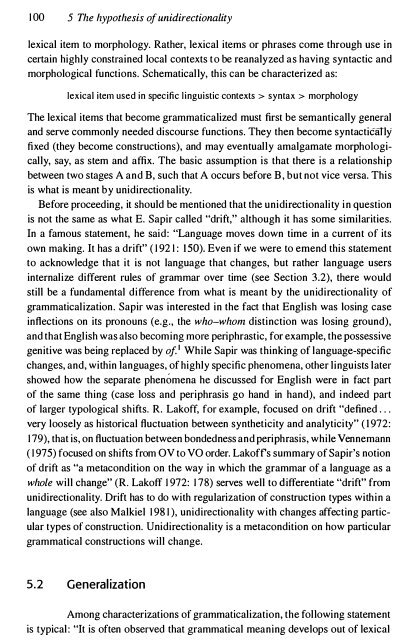Gram - SEAS
Gram - SEAS
Gram - SEAS
Create successful ePaper yourself
Turn your PDF publications into a flip-book with our unique Google optimized e-Paper software.
100 5 The hypothesis of unidirectionality<br />
lexical item to morphology. Rather, lexical items or phrases come through use in<br />
certain highly constrained local contexts to be reanalyzed as having syntactic and<br />
morphological functions. Schematically, this can be characterized as:<br />
lexical item used in specific linguistic contexts > syntax > morphology<br />
The lexical items that become grammaticalized must first be semantically general<br />
and serve commonly needed discourse functions. They then become syntacticiilly<br />
fixed (they become constructions), and may eventually amalgamate morphologically,<br />
say, as stem and affix. The basic assumption is that there is a relationship<br />
between two stages A and B, such that A occurs before B, but not vice versa. This<br />
is what is meant by unidirectionality.<br />
Before proceeding, it should be mentioned that the unidirectionality in question<br />
is not the same as what E. Sapir called "drift," although it has some similarities.<br />
In a famous statement, he said: "Language moves down time in a current of its<br />
own making. It has a drift" (1921: ISO). Even if we were to emend this statement<br />
to acknowledge that it is not language that changes, but rather language users<br />
internalize different rules of grammar over time (see Section 3.2), there would<br />
still be a fundamental difference from what is meant by the unidirectionality of<br />
grammaticalization. Sapir was interested in the fact that English was losing case<br />
inflections on its pronouns (e.g., the who-whom distinction was losing ground),<br />
and that English was also becoming more periphrastic, for example, the possessive<br />
genitive was being replaced by of I While Sapir was thinking of language-specific<br />
changes, and, within languages, of highly specific phenomena, other linguists later<br />
showed how the separate phenomena he discussed for English were in fact part<br />
of the same thing (case loss and periphrasis go hand in hand), and indeed part<br />
of larger typological shifts. R. Lakoff, for example, focused on drift "defined . ..<br />
very loosely as historical fluctuation between syntheticity and analyticity" (1972:<br />
179), that is, on fluctuation between bonded ness and periphrasis, while Vennemann<br />
(1975) focused on shifts from OV to VO order. Lakoff's summary of Sapir's notion<br />
of drift as "a metacondition on the way in which the grammar of a language as a<br />
whole will change" (R. Lakoff 1972: 178) serves well to differentiate "drift" from<br />
unidirectionality. Drift has to do with regularization of construction types within a<br />
language (see also Malkiel 1981), unidirectionality with changes affecting particular<br />
types of construction. Unidirectionality is a metacondition on how particular<br />
grammatical constructions will change.<br />
5.2 Generalization<br />
Among characterizations of grammaticalization, the following statement<br />
is typical: "It is often observed that grammatical meaning develops out of lexical
















